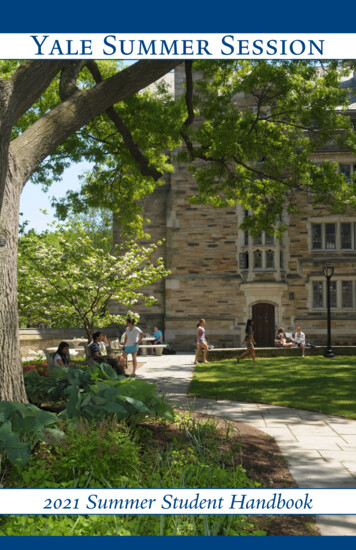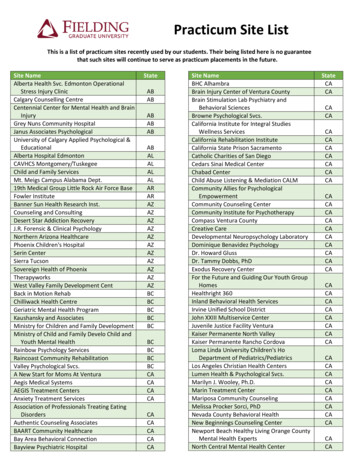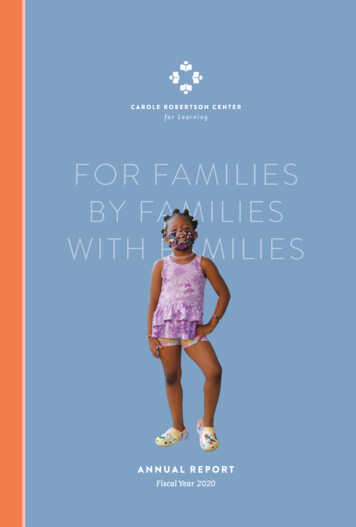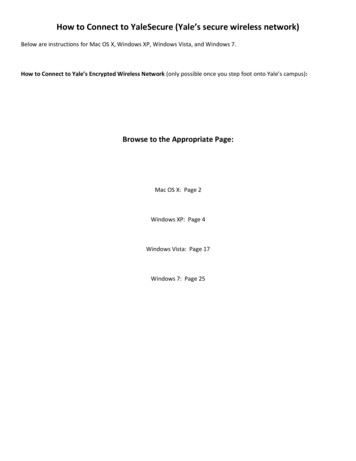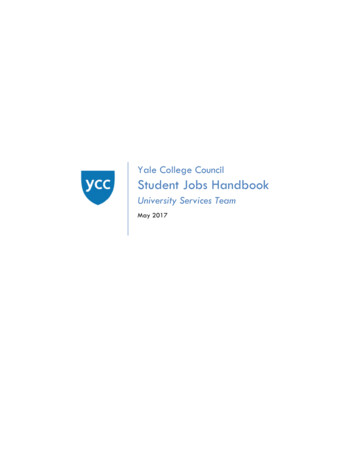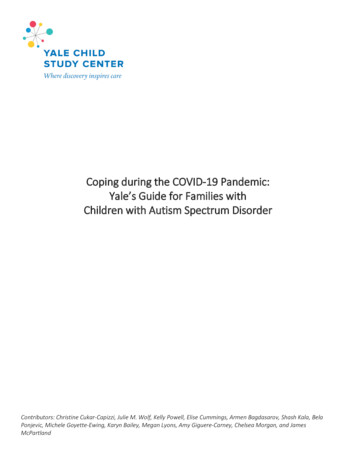
Transcription
Coping during the COVID-19 Pandemic:Yale’s Guide for Families withChildren with Autism Spectrum DisorderContributors: Christine Cukar-Capizzi, Julie M. Wolf, Kelly Powell, Elise Cummings, Armen Bagdasarov, Shash Kala, BelaPonjevic, Michele Goyette-Ewing, Karyn Bailey, Megan Lyons, Amy Giguere-Carney, Chelsea Morgan, and JamesMcPartland
Table of ContentsI.Cover letterII.Resources for ParentsIII.Helping Children with ASD to Understand COVID-19IV.Visual Support Strategies for Families of Children with ASD during the COVID-19 PandemicV.Visual Teaching TasksVI.Resources for Teens with (and without) ASD during the COVID-19 PandemicVII.Resources for Siblings of Children with ASD during the COVID-19 PandemicVIII.Social Games to Play as a Family2
3-31-2020Dear Families,The spread of the novel coronavirus has resulted in unprecedented changes to the daily lives of childrenand families. We realize these changes may be particularly challenging for individuals with autismspectrum disorder (ASD), who tend to benefit from structure and routines. As such, the DevelopmentalDisabilities Clinics at the Yale Child Study Center has compiled autism specific resources for individualswith ASD and their families. It is our hope these resources can help provide ideas and support familiesas they develop new routines within their homes. We have included information related to COVID-19and a variety of other topics. Please remember to take care of yourselves and your families!Best,The Developmental Disabilities Clinics at the Yale Child Study Center3
II. Resources for ParentsNote to parents: It is important for parents to care for themselves, both physically and emotionally, and setrealistic expectations as they assume new roles in the family (for example, working from home parent, teacher,therapists, sports coach, etc.). We highly recommend that parents, and in particular those that are raisingchildren with special needs, find opportunities to connect with loved ones outside of the home, other parentsof children with special needs, and friends, during this unprecedented time of social distancing. As you are likelyaware, social distancing is better understood as physical distancing; maintaining social connections is of highimportance. While each day that passes can sometimes feel like days/weeks, we encourage you to take thingsone day at a time. Many parents are expressing feelings of stress, guilt, shame, and worry, among othernegative emotions at this time. Simultaneously, you may also be experiencing joy, humor, love, and deepconnection to your loved ones. Please remember that you are not alone.Zero to Three offers resources for parents of young children at home during the COVID-19 outbreakThe following are reviewed in more detail:1) Tips on self-care2) Paying attention to how you are feeling3) Imaging your child’s behavior as communication4) Making time for self-care5) Taking care of yourself (including possible activities)In the spirit of self-care, there are many apps and websites offering free yoga, mindfulness, and workoutclasses. Some may be appropriate to participate in with your child. At-home workoutsPlanet Fitness is offering live online classes for members as well as non-membersPeloton is offering a 90-day free membershipYogaYoga International is offering a 30-day free membership with access to articles and instruction regardingmindfulness activities, meditation, and all levels/styles of yoga.CorePower On-Demand is currently offering free classesMindfulness2000 Mindfulness exercises are offeredPalouse Mindfulness offers users free resources on learning about and practicing mindfulnessCalm and Headspace are 2 highly reviewed and utilized mindfulness apps; however, there are manyothers available.Specific to sleep, there are Tracks to Relax guided sleep meditationsParent groups and networks can be invaluable sources of support, guidance, and information. Here are severalConnecticut-based parent groups on Facebook: CT Special Needs Families and Networking Group Connecticut Family Support Network Connecticut Special Needs Network CT Autism Parents4
III. Helping Children with ASD to Understand COVID-19Below are some resources for helping your child with autism spectrum disorder to understand the coronaviruscrisis:RESOURCES FOR PARENTS AND CARE PROVIDERS WHEN TALKING WITH CHILDRENThe American Academy of Child Psychiatry provides 14 tips for talking to children:https://www.aacap.org/App Themes/AACAP/Docs/latest news/2020/Coronavirus COVID19 Children.pdfChildren’s National offers answers adults can offer to answer common questions children may id-19-faqs-for-kids/SAMSA has a downloadable publication that provides guidance for talking with children of different ages inhelpful ways: g-Infectious-Disease-Outbreaks/PEP20-01-01-006The National Association of School Psychologists has guide for parents addressing talking to children andcreating structure and predictability for daily life at home, available in English, Spanish, Chinese, Amharic,Korean, French, and arent-resource (seeright side column on page)Autism Speaks has also provided some resources pertaining to COVID-19: tion-and-resources k tism Society COVID-19 Toolkit: https://www.autism-society.org/covid-19/From Duke’s Center for Autism and Brain Development How to talk to your child with ASD about frightening situationsRESOURCES TO SHARE WITH CHILDRENThese social stories help explain the COVID virus to children with autism spectrum disorder: -Autism-Educator-.pdf oronavirus-COVID-19-Social-Story-5319239 Free-Printable-.pdf5
Duke Center for Autism and Brain Development has provided helpful resources for children with developmentaldisabilities, including ASD. This would be appropriate for young children as well. Flu picture story Visual supports: Social Story about not sharing germs Visual supports: Hand-washing stepsAdditional visual supports dealing with COVID-19: his comic book from NPR may appeal to younger school age kids or kids who like picture books to calm fearsabout catching the -the-newcoronavirusThis children’s guide is appropriate for school-age ids-guide.htmlThis article from PBS provides parents with language for talking to their kids and has cool links to publictelevision episodes that address different aspects of health (washing hands, germs, resting when you are lk-to-your-kids-aboutcoronavirus?fbclid ncRW8aVCU68Additionally, this Daniel Tiger episode - “Daniel’s Very Different Day / Class Trip to the Movies” (Season 3,Episode 18) - helps children learn how to deal with change and disappointment. It is available for purchase onAmazon Prime 32X5F/ref atv dl rdrACTIVITIES FOR AT HOME LEARNING WHILE SCHOOL IS OUT:Scholastic is offering fun online learning for pre-k through grade six and upport/learnathome.htmlThis website has a very comprehensive list of companies offering free online learning while schools are closeddue to m/6
IV. Visual Support Strategies for Families of Children with ASD during the COVID-19 PandemicFor many children with ASD and their families, the transition from a structured daily schedule in home, school,or community programs to extended unstructured time at home is challenging. Visual supports can be a helpfulway to create structure, provide guidance, and encourage independence whileyour child is at home. Here you’ll find some different types of visual supports(with examples), strategies for using them with your child, and additionalresources for creating your own visual supports.1. Visual schedules are visual prompts used to help individuals predict orunderstand upcoming events. They show the sequence of activities that willoccur using written words or images. You can use clip art, your own pictures,or written words in a list. Put the visual schedule wherever your child can seeit (e.g., phone, iPad, refrigerator). Here are some examples of visual schedulesfor everyday activities and for teaching new skills (e.g., brushing teeth,toileting, increasing independence with cooking):In the HomeIn the CommunityToothbrushing7
ToiletingMeal Preparation and Cooking2. Activity schedules are visual schedules that use pictures or words to describe a sequence of activities tofollow and engage in. They can include leisure activities, playing with toys, tasks around the house, or havinga snack. Activity schedules promote independence and self-management skills.8
Here are some helpful teaching strategies to keep in mind while using activity schedules:1) Start with short, simple activities that your child alreadyknows how to complete independently.2) Have a binder with activities and a reinforcer(something your child really enjoys) at the end.3) Start with items on a table, and work up to furtherdistances.4) Prompt (point/complete/turn page/reinforce) frombehind your child.5) Start with close-ended activities that have a clear startand end (e.g., puzzles).6) Teach use of timer to include more open-endedactivities (e.g., painting).Modeling can also be a useful visual support for your child. Live modeling uses opportunities as they’re naturally occurring, and you can comment on them. Video modeling uses videos to provide a visual model of various skills. These videos feature an individualwith ASD, parent, or other actors going through the process of completing a task. You can also pause thevideo if needed for your child to perform each step before continuing on to the next step. Here aresome examples:Teaching Play SkillsPlaying with Mr. Potato HeadTeaching Social SkillsPicking up on cues that friend is boredhttps://www.youtube.com/watch?v BuDSiZkr1Pchttps://www.youtube.com/watch?v Bmz c3z3JUISocial stories are short descriptions of situations or activities used to clarify social expectations. They provideguidance and instructions for responding to various types of social situations, based on your child’s experiencesor responses to situations.9
Here is some advice on building a social story for your child:1) Use photos or images of events, people and places, paired with words.2) Write in 1st person from your child’s perspective.3) Include descriptive sentences.a. The teacher likes it when I listen while she’s talking.b. The other students want the classroom to be quiet so they can learn.4) Include directive sentences.a. If I need a break, I can hold up my break card.b. I will try to stay quiet while my teacher is talking.5) You can use this downloadable, personalized social story to get you sonalized-teaching-storiesAdditional resources to help you use visual supports with your child:AppsiGet Cooking: Cooking Vocabulary and Create Recipe Photo Sequence Books rompts: Visual support tools ModelMe Kids: Teaches kids about reading different emotions. d550027186First Then Visual Schedule: Visual schedules for caregivers l-schedule/id355527801Visual Schedule Planner: A visual support to ease transitions, anxiety, or who simply need a way tovisually represent their day. -planner/id488646282Other resources Visual Supports and Autism Spectrum Disorders from Autism SpeaksAn explanation of when and why your child could benefit from different types of visual t/files/2018-08/Visual%20Supports%20Tool%20Kit.pdf Visual Schedules: A Practical Guide for Families from University of UtahTips and resources to create a visual schedule for your child. https://ed-psych.utah.edu/schoolpsych/ dules-Practical-Guide-for-Families.pdf Functional Activities for Younger and Older Students from Pyramid Educational Consultants, Some fun(and functional) activity ideas for children of varying ctivitiesYoungerAndOlderStudents.pdf “Making Visual Support Work in the Home and Community: Strategies for Individuals with Autism andAsperger Syndrome” by Jennifer L. Savner and Brenda Smith Myleshttps://books.google.com/books/about/Making Visual Supports Work in the Home.html?id sXLKLnzFKeIC “Visual Strategies for Improving Communication” by Linda A. tegies-improving-communication/10
V. Visual Teaching TasksMany children with autism spectrum disorder are visual learners. They benefit from tasks being structured in away that is visual in nature, and in which task expectations are clear. This type of structure also helps them tocomplete work as independently as possible.The following pages provide some examples of visual tasks that teach a variety of skills. Feel free to borrowthese ideas, or work with your child’s classroom teacher to develop tasks targeting your child’s specificeducational goals.There are also many websites with printable educational worksheets and “file folder tasks.” Here’s a websitethat’s a great place to start, with links to free, printable file folder tasks organized by category:https://www.earlywood.org/Page/67611
12
13
14
15
VI. Resources for Teens with (and without) ASD during the COVID-19 PandemicINFORMATION ON COVID-19There is a lot of information (and misinformation!) about coronavirus. Below, are some basic facts aboutcoronavirus, originally published on March 14th from scientists from Harvard Medical School.What caused coronavirus?This coronavirus is believed to have started in animals and then passed on to humans at a live animal market inChina.Why now?This is actually not the first time that there has been a widespread virus that started in animals and spread tohumans. Another example is the severe acute respiratory syndrome (SARS) outbreak in 2002 that was causedby a different coronavirus. That virus eventually was contained. Doctors, scientists, and government officials areworking hard to do the same with this newest coronavirus.Can our pets get sick?There is little evidence that domesticated pets, including dogs and cats at home, are likely to get sick from thisnew coronavirus, or spread the virus.STAYING HEALTHY1) Sneeze or cough into tissues (and throw them away) or sneeze or cough into your elbow. These behaviorshelp keep germs from traveling and making other people sick.2) Try to avoid touching your mouth, eyes, and nose, which are places where the germs can enter your body.3) Try to get enough sleep and eat well to help your body stay healthy.4) And most importantly, WASH YOUR HANDS FREQUENTLY!Here’s the correct way to wash your hands (It may seem obvious but most of us actually don’t do itcorrectly!):https://www.youtube.com/watch?v 3PmVJQUCm4EHere’s an interesting video on how germs spread and why we should wash our hands:https://www.youtube.com/watch?v I5-dI74zxPg16
ADDITIONAL TIPS & REMINDERS Everyone is working hard to manage the virus. Do your part by washing your hands and respecting socialdistancing suggestions. However, it is normal to also feel nervous, scared, and confused. If you feel thisway, talk to your parents or guardians. Stay calm! Others around you, especially younger siblings and children, may model your behavior. If youremain calm, that could help others remain calm too! Prepare yourself, to the best of your abilities, for changing plans. There is a good chance that trips ortravels you have planned for or activities you wanted to attend have been cancelled. Continue to talk toyour parents or guardians about any upcoming changes in your family plans.The information above was taken 2NOW THAT YOU’RE AT HOME STAY ORGANIZED For many of us, this is the first time we’ve needed to do school from home. So, it’s important to stayorganized! Here are some great ways to stay organized:1) Online planners/calendars https://www.google.com/calendar/about/ https://www.canva.com/create/daily-planners/ https://www.mystudylife.com/ irus-home-school/2) Or get creative! https://bulletjournal.com/pages/learn AY ENGAGED The next page has a great list of books, specifically for teens with autism spectrum disorder17
10 Books for Teens with AutismNon-fiction:1) The Reason I Jump: The Inner Voice of a Thirteen-Year-Old Boy with Autism by Naoki Higashida2) Thinking in Pictures, Expanded Edition: My Life with Autism by Temple GrandinFiction:3) The Curious Incident of the Dog in the Night-Time by Mark Haddon4) Anything but typical by Nora Raleigh Baskin5) Rain Reign by Ann M. Martin6) Mockingbird by Kathryn ErskineEducational:7) The Asperkid's (Secret) Book of Social Rules: The Handbook of Not-So-Obvious Social Guidelines forTweens and Teens With Asperger Syndrome by Jennifer Cook O'Toole8) Uniquely Human: A Different Way of Seeing Autism by Barry M. Prizant and Tom Fields9) The Autism Playbook for Teens: Imagination-Based Mindfulness Activities to Calm Yourself, BuildIndependence, and Connect with Others by Carol Moog and Irene McHenry10) Asperger's Teens: Understanding High School for Students on the Autism Spectrum by Blythe N.Grossberg You can also download over 300,000 e-books from the New York Public r-free-031820 Audible is currently making many youth audiobooks available free of chargehttps://stories.audible.com/start-listen Bored of reading? Then check out:1) Zoo .html2) Online Broadway -33) Many streaming services are now offering free /www.amazon.com Prime VideoGreat TV shows (including this one about individuals with yables18
VII. Resources for Siblings of Children with ASD during the COVID-19 PandemicSiblings of children with autism spectrum disorders have their own unique needs, and these needs may beheightened during this period of increased time together as a family. Here are some ways you can support yourchildren who do not have ASD:1) Acknowledge Your Child’s Experience: Recognize that it may be challenging for your child to have thewhole family together in the same house all the time. Siblings may have numerous and complex feelingsabout their experience as a sibling of someone with ASD, ranging from pride and joy to guilt andfrustration. Realize that these feelings may all be amplified during this time. Allow your child to expresstheir feelings; listen openly, be supportive, and try not to judge or reprimand their honest feelings.2) Manage Expectations:a. Expect household responsibilities from all of your children (with or without ASD), appropriate totheir developmental level. This builds skills for all children and prevents feelings of unfairness.Apps like Chore Bot t/id629797415) canhelp structure and provide visual support for chores and, if appropriate, allowance.b. Encourage your typically developing child to help out as appropriate – for example, they mightplay a board game with their sibling to work on turn-taking skills. However, be sure yourexpectations are not too high. Your child should not function as another parent or adisciplinarian.c. Expect typical sibling rivalry. All children argue with their siblings – do not deny this “right” toyour typically developing child by telling them, “You should know better.”3) Ensure Safety: If your child with ASD has any aggressive behaviors, ensure that your family has a plan inplace so that your typically developing child knows what to do if they ever feel unsafe. If you arehomebound, this might mean creating a “safe space” in your home where they can go (e.g. theirbedroom).4) Create One-on-One Time: To the extent possible, try to find some one-on-one time with each of yourchildren. Siblings of children with ASD sometimes feel they get less of their parents’ attention, somaking a point to have some time dedicated just to them can be very beneficial. This could be as simpleas watching a show together or playing a board game.5) Allow Private Time: During this increased time together, you probably sometimes just long for a break.The same is likely true for your children! Allow your child to have some time to themselves to justunwind from the stressors of this unique time.6) Provide Opportunities for Social Support: The inability to hang out with their friends during this time ofsocial distancing may be especially isolating, so make sure you give your child opportunities to text and“see” their friends via Facetime / Zoom / Skype and other social media outlets (as appropriate for theirage). For teens, you might pursue social support specifically for siblings of children with disabilities.“SibTeen” is a Facebook group where teens who have a sibling with a disability can h-others-sibs/meeting other sibs online/sibteen19
To help your child process their feelings, there are a number of workbooks, journals, and toolkits for siblingsof children with autism and other disabilities: The Sibling Slam Book: What It's Really Like to Have a Brother or Sister with Special Needs (Don ther-Special/dp/1890627526/ A Sibling’s Guide to Autism (Autism ings-guide-autism Life as an Autism Sibling: A Guide for Teens (Organization for Autism e-as-an-autism-sibling-a-guide-for-teens/ Autism, My Sibling, and Me (Organization for Autism ism-my-sibling-and-me/ Sesame Street & Autism: The Sibling ent/uploads/2015/08/SiblingGuide.pdf20
VIII. Social Games to Play as a FamilyHere are some resources for finding games you can play as a family, to encourage social interaction and socialskill building (and just for fun!). The following book is a great resource for group games, and highlights developmental skills targeted byeach game:Best New Games by Dale N. LeFevre, available on LeFevre/dp/1450421881 This website has a large database of icebreaker and team-building games, and allows you to search byage-appropriateness, number of people, etc.:https://www.jubed.com/ Special Olympics has an activity guide for developing athletic and team building skills for young .pdf This website has great suggestions for adapting popular children’s games for children with -games-adapted-for-children-with-autism Here are some additional websites with fun group games for groups-of-kids/21
Children with Autism Spectrum Disorder Contributors: Christine Cukar-Capizzi, Julie M. Wolf, Kelly Powell, Elise Cummings, Armen Bagdasarov, Shash Kala, Bela . Yoga International is offering a 30-day free mem





